Sucha Beskidzka
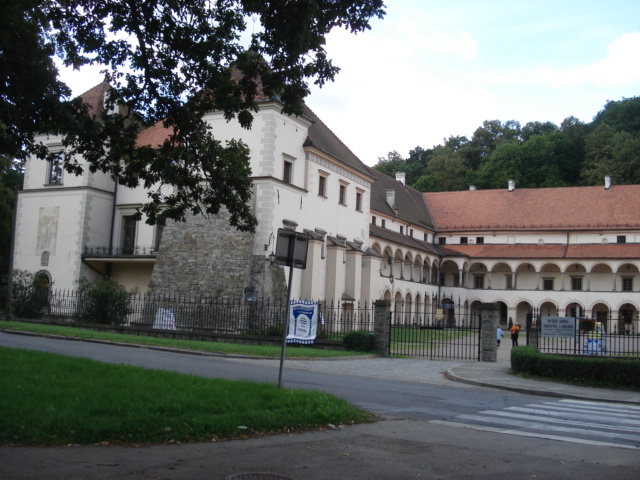
The castle of Sucha Beskidzka
Distance
33 km NV, 44 km NE, 21 km SE, 35 km NE, 42 km NV, 54 km NE, 6 km E, 45 km E, 37 km NE, 52 km SE, 50 km NV, 32 km SE, 21 km NV, 73 km SE, 34 km NV, 22 km, 43 km SE, 34 km VPopulation
10.000
Location and history
Sucha Beskidzka, a rural town in Powiat Suski, is picturesque in the Stryszawka and Skawa river valleys, centrally in the western Beskidy Mountains and in the border area between Beskid Makowski, Beskid wywiecki and Beskid Mały. The city has for many years been a local center, both in business and administrative terms; its importance as an educational center is increasing.
Sucha Beskidzka was granted commercial property rights in 1405. Towards the end of the 15th century. the population grew substantially, especially as a result of the influx of farmers and herdsmen (from Volhynia).
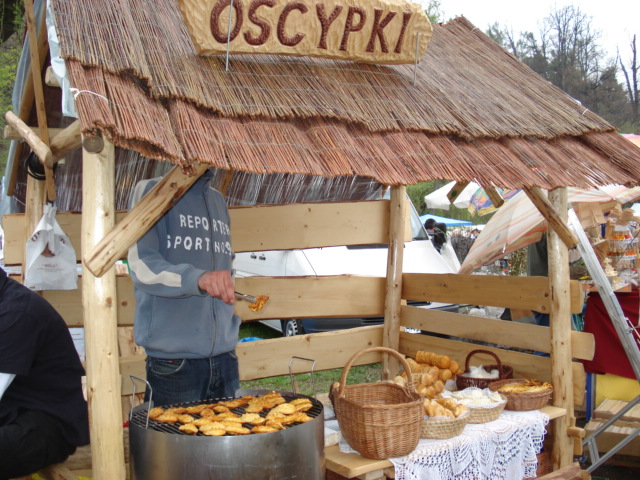
Sales of oscypki (smoked sheep cheese) at the weekly market in Sucha
In 1742, King August II granted Sucha a privilege to hold 8 markets during one year. Sucha Beskidzka then becomes a well-known market town.
After the partition of Poland (1772) and until 1918, Sucha belonged to Austria-Hungary.
During World War II, Sucha was occupied by the Germans and was also placed under the German Empire, whose border during the war years went along the river Skawa. On the eastern side of Skawa, the so-called General Government Poland was established.
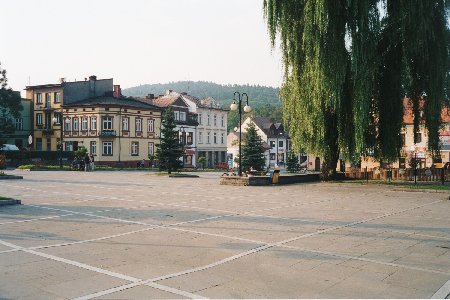
From the square
Tourist attractions
The castle of Sucha
The Renaissance castle in Sucha is called it “Little Wawel”. It is a three-story building with four corner towers and a square courtyard with east side entrance. The south wing and the west wing on two floors are provided with archways on both floors, the arches on the ground floor being carried by square pillars, but on the 1st floor of Tuscan columns. The bell tower contains a chapel with a ceiling painting that represents “The Secrets of the Holy Mass According to the Life of Jesus”. On the first floor of the west wing is the hall of knights.
In the years 1554-1580, Kasper Suski erected here a castle of wood and stone, probably as a substitute for a completely burnt-out, wood-built manor. The castle was expanded in 1608-1614 by Piotr Komorowski into a considerable Renaissance style manor residence.
During the 18th-20th century. the castle belongs to the genera Wielopolski, Branicki and Tarnowski.
While the Branicki genus owned the site, the east wing with the main gate – at some point before 1867 – was demolished. At the same time, the neo-Gothic orangery emerged like a stone wall around the park. In the years 1882-87, Władysław Branicki undertook a general restoration of the castle.
During World War II, the castle was taken over by the Germans and later by the Soviet army. Great book and museum values were scattered, robbed or destroyed.
After the war, a high school housed in the building. 1968-86 The State Art Collections at Wawel began work on renovating the castle to prepare it for serving museum purposes. In 1996, the castle complex was taken over by Sucha Municipality.
The castle buildings today contain a municipal cultural center, an art gallery, a local cultural association, a music club and – not least – on the ground floor restaurant “Kasper Suski”; in an attached wing there is a hotel.
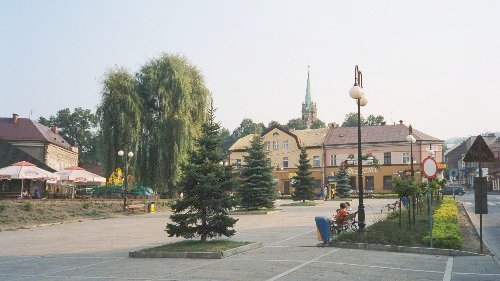
The square in Sucha Beskidzka seen with the church in the background
The Old Church and the New Church together with the monastery building and four chapels form a church and monastery complex.
The old church that was consecrated to “The Blessed Virgin Mary Visitation” is a typical Gothic building with Renaissance elements; it was erected together with the monastery, now serving as a rectory, by the former owner of Sucha, Piotr Komorowski, in the years 1613-1614. Under the church choir is a crypt with burial chamber for the Komorowski family. In the church choir there is a ceiling painting depicting the Ascension. Church altars – the main altar and six side altars are decorated in rococo style.
The old church is associated with the new church with a low building, also used as a sacristy.
The new church was designed by Teodor Talowski and built 1897-1908. The construction was first and foremost paid for by the Branicki family as well as the railway staff in Sucha. The building style is picturesque eclectic, especially Gothic and Romanesque elements.
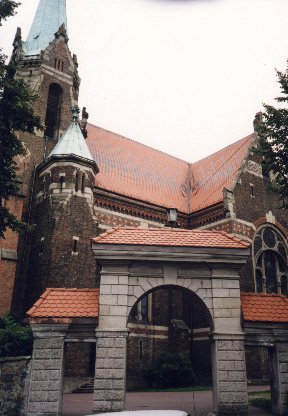
The parish church in Sucha
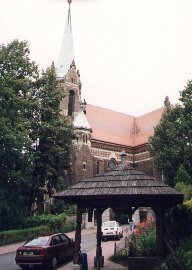
The parish church in Sucha
Karczma “Rzym” –
ie: The inn with the name “Rome”, is located on the open space in the center of Sucha and is a beautiful example of a now extinct wooden architecture, specifically the traditional, folk style of building in the Beskidy area. The inn is a log cabin with a roof that has a fall to four sides. Along the entire front facing the square, a covered terrace has been created under the roof.

Kroen Rzym
The inn was built in the second half of the 18th century. at a time when Sucha had become a market town with 8 annual markets. The inn's interior is equipped in a regional style, similar to the local mountain lodge tradition.
The name of the inn comes from the legend of Pan Twardowski, who met his fate in the form of the devil and thus the forfeiture in Rome – not in the city of Rome as predicted, but in the inn “Rome”.
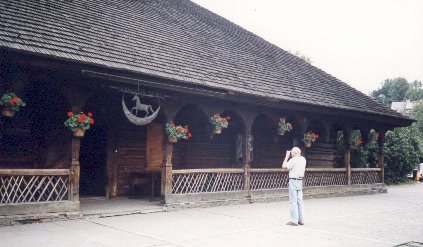
Kroen Rzym
The chapel commemorates the Rebels from the Bar on Mount Jasień .
This is a very small Renaissance style building, with Gothic elements. The chapel was built circa 1773 in memory of the fighting in 1771 between the rebels and the Russian army. The chapel has great symbolic (patriotic) significance for the local population.
Accommodation
Booking.com
Sucha Beskidzka City official site (Polish version) – with practical information for tourists
Links regarding accommodation in the area:
Holiday house at Maków Podhalański (Southern Poland)
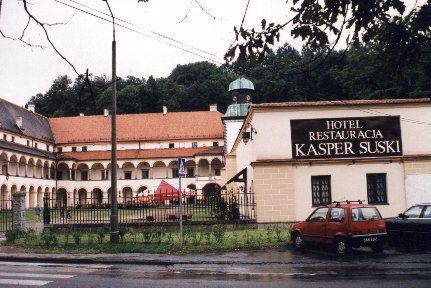
The castle of Sucha
Other Internet sites and sources
Sucha Beskidzka City official page (Polish version)

The square looked towards the castle
Translated into English by Google Translate. Spangshus.dk accept no liability for any errors or omissions in translation.
Map

Rating
Search
Most used tags
churches (205) Castles (86) Monasteries (79) Town walls (74) Lakes (71) Town halls (67) Rivers (65) Castles1 (62) Mansions (55) Museums (51) Regional museums (38) Town gates (36) Abbey churches (35) Castle ruins (30) Cathedrals (26) Forests (25) Health resorts (24) Water sports (23) Mounds (23) National parks (22)Click for all tags
Denne side er også tilgængelig på dansk. This page and contents is (c) Copyright 2018- www.spangshus.dk. Based on Inviator software by ISCA Software